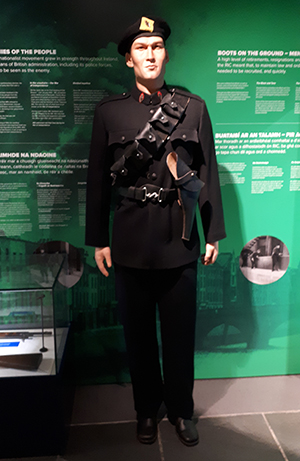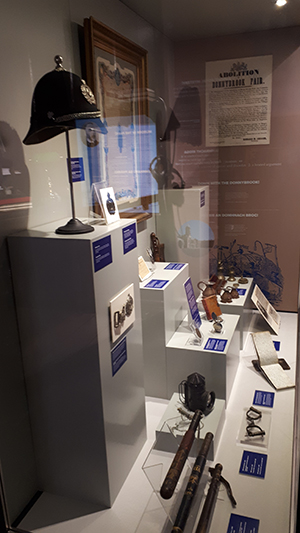MUSEUM EYE: Garda Museum
Published in Book Reviews, Issue 2 (March/April 2019), Reviews, Volume 27Garda Museum
Dublin Castle
museum@garda.ie, +353 (0)1 6669998
By Tony Canavan
The Garda Museum is located in refurbished vaults in the Treasury Building of the Dublin Castle complex. It houses a state-of-the-art exhibition utilising traditional and modern display techniques, and takes the visitor on a journey from the early days of British policing in Ireland up to the tasks and equipment of An Garda Síochána today. The location is appropriate insofar as Dublin Castle once housed the headquarters of policing in Ireland.

A time-line of Irish policing begins in 1782 and follows the various developments from local police forces to the Royal Irish Constabulary (RIC) and on to the present. This historical time-line is complemented by the nearby displays of old police rattles (before whistles became standard equipment), Irish Constabulary epaulettes and portraits of prominent commanders of the force. Some space is given to Robert Peel and his founding of an Irish Constabulary in 1836. This takes a somewhat benign view of the Constabulary, making little or no mention of the fact that this was an armed force with military training. The establishment of the Dublin Metropolitan Police (DMP) is also covered. In this area, too, is a display about infamous crimes that occurred in the nineteenth century, such as the Phoenix Park murders and the theft of the so-called Irish crown jewels.

The area devoted to the Irish Constabulary continues with display cabinets containing uniforms, medals, truncheons, handcuffs and so on. There is an oblique explanation of how it became the ‘Royal’ Irish Constabulary in recognition of its suppression of the 1867 Fenian rising. There is little information on the Fenians or what their rebellion was about. Beyond this there is an interesting display on the importance of the bicycle to the RIC and how it enabled them to carry out their many duties more effectively. Another side to the force is revealed by the large bottle of ‘RIC ginger wine’. Not until a panel on the Land War of the late nineteenth century, however, do we get an indication of the RIC as an oppressive force.
It was responsible for maintaining order and enforcing evictions. In this context we are told that the force was ‘armed and unpopular’.
The visitor arrives at the twentieth century with a gallery entitled ‘Birth of a Nation’. This may be a snappy title but is inaccurate, as the Irish nation had existed for centuries. The exhibit on the War of Independence emphasises the role played by certain RIC men who were on Michael Collins’s side but cannot ignore the actions of the Black-and-Tans and the Auxiliaries in fighting the IRA. Not, however, until we get to ‘A New Police Force for a New State’ does the visitor learn about the Garda. The Civil War and the mutiny in the ranks of the nascent police force are both dealt with. It is to the force’s credit that it was able to operate during the Civil War without being directly drawn into the conflict, enabling it to continue peacefully policing the community afterwards.

There is a very good video on the history of the Garda, showing the type of person who joined, the approach to policing and major developments. The bike also played a key role in the early days of the Garda but the force was not slow to adopt motor transport and other forms of technology, such as two-way radios, although in terms of social history the recruitment of women as Ban-Ghardaí was perhaps of most significance.
From here it is but a short step to the final section of the museum, ‘A 21st Century Service’. This looks at the various roles the Garda plays in Ireland today, from tackling crime to service with the United Nations, and how the force has developed with air support, sub-aqua and public order units. The equipment of all these branches is on display, including a powerful motorbike, scuba gear and the riot gear worn by the public order unit. All the stuff that cops do on TV is represented, such as crime scene investigation, ballistics analysis and CCTV surveillance. One of the most interesting things on display is the ‘face evolver’, a digital way of identifying suspects from witness descriptions. A lighter side is revealed with the Garda band, but the sacrifices made by serving Gardaí is not forgotten, as the museum ends with a roll of honour of those killed in the line of duty.
I enjoyed this museum and found it interesting, although it might more appropriately be described as ‘a museum of policing in Ireland’, as quite a lot of space is given to the police forces under British rule. I was struck, too, by the attempt to establish continuity between the old RIC and An Garda Síochána. The RIC is largely portrayed as a ‘normal’ police force and the impression is given that the Garda merely carried on from where they left off. Whoever designed the museum seems embarrassed by the idea that the Garda was a force born out of armed revolution and that it was consciously established not to be like the RIC.
Tony Canavan is editor of Books Ireland.
















